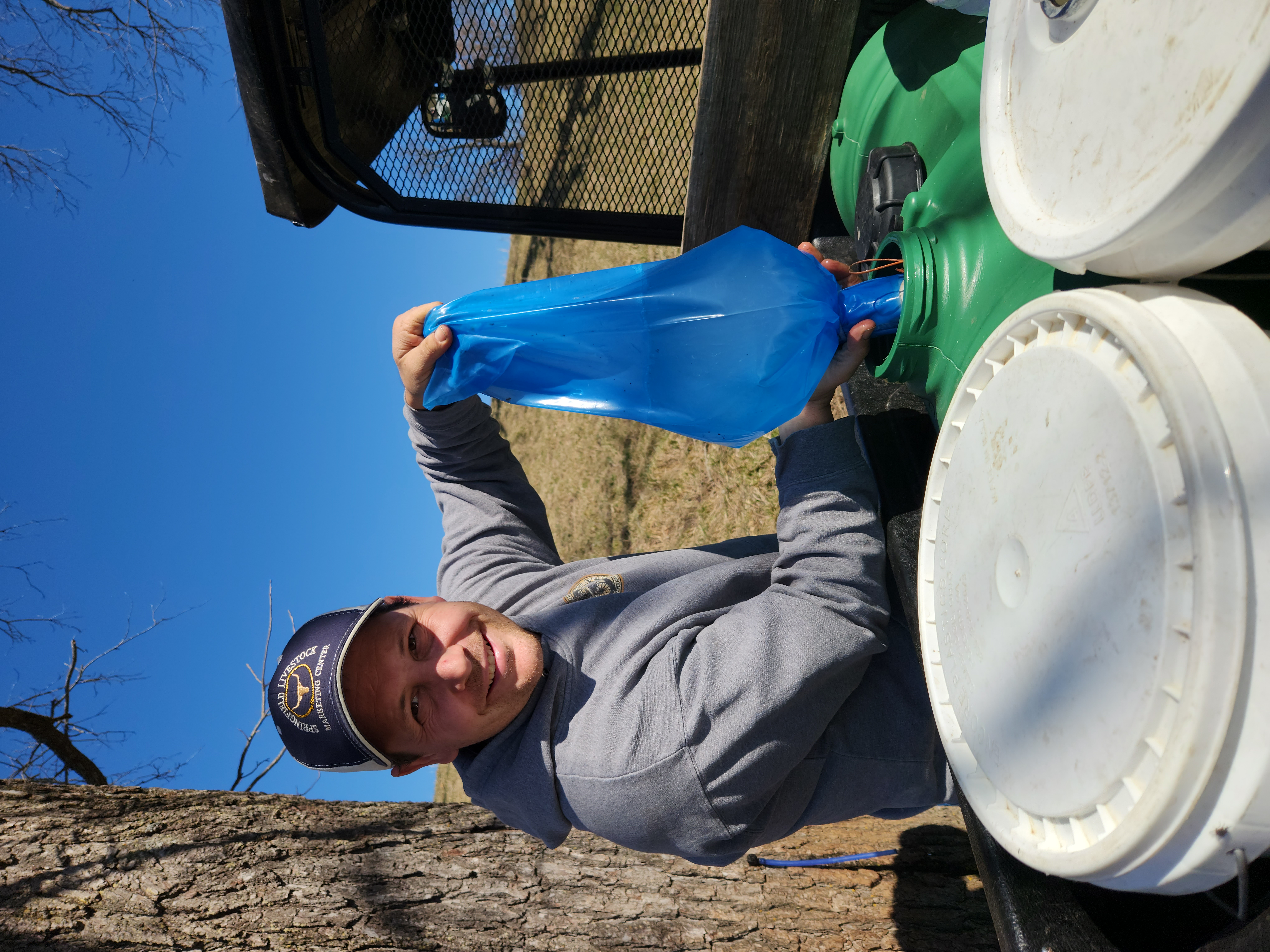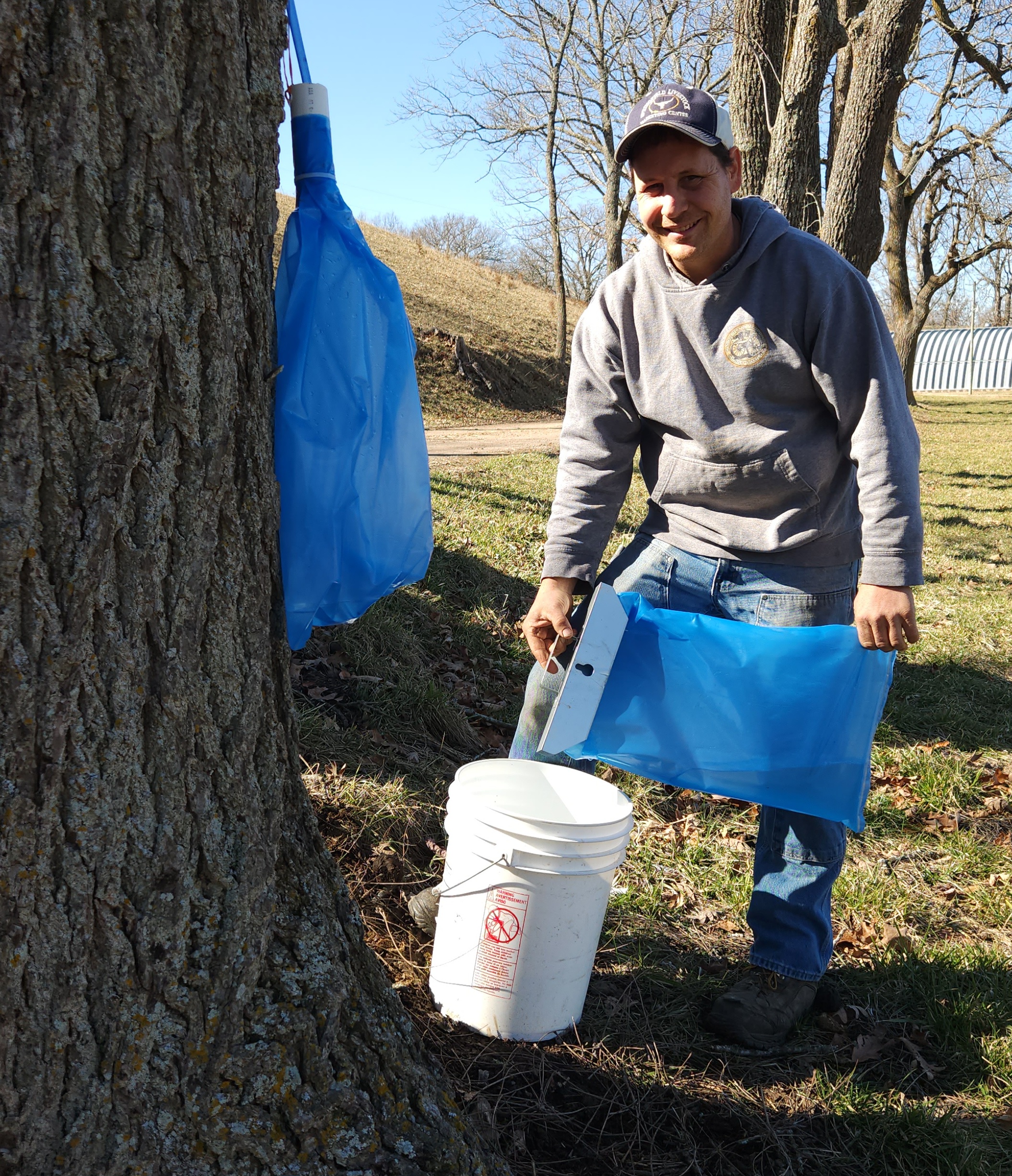Four years ago, Matthew and Leah VanderWaal started looking for ways to supplement their income from farming, Matthew’s welding jobs and their baking business.
Then, the south Webster County homesteaders heard about tapping the sap from black walnut trees to make syrup.
The VanderWaals were intrigued.
Like many Ozarkers, they had thought of tree sugaring — or tapping trees for sap to simmer into syrup — as a late-winter custom mainly in northern regions with an abundance of sugar maples.
So learning that black walnut trees native to the Ozarks can also yield sap for a sweet and tasty syrup was good news. There are plenty of them on the VanderWaals’ property, a 75-acre farm where they raise cattle, chicken, goats and sheep.
Soon, passersby were intrigued, too, as bright red Folgers cans dotted the family’s farm.
“Basically, we had all these coffee cans attached to the trees and all my neighbors wondered what I was doing,” Matthew VanderWaal said.
At that point, he and Leah hadn’t even tasted black walnut syrup, but after making their first batch of it that year, they fell in love with it, Matthew said.
“It’s just an amazing flavor.”
Tree sugaring is gaining popularity
Whether they have heard about other Ozarkers tapping trees or yearned to try tree sugaring ever since reading about author Laura Ingalls Wilder’s childhood experiences in “Little House in the Big Woods,” more southwest Missourians seem to be taking an interest in backyard tree sugaring, according to VanderWaal and University of Missouri Extension field specialists.
“During COVID, sourdough bread became a thing, a lot more people had an interest in gardening and I think this kind of fell into that category,” said Sarah Havens, University Extension Southwest Regional Director and a forester who teaches tree sugaring workshops.
Last February, the Extension sponsored a workshop at the Springfield Botanical Gardens in Nathanael Greene/Close Memorial Park, and Extension horticulturist Kelly McGowan says she hopes to offer another workshop there next year.
An easy, inexpensive hobby
Tree sugaring is an easy and inexpensive hobby to try, McGowan said. Late winter is the time of year to try it, too, while the cycle of freezing nighttime temperatures and warmer daytime temperatures continues and before spring buds appear.
“You don’t need a lot of equipment or special skills to do it,” McGowan said.
Identifying trees suitable for tapping is the first step.

Many Springfieldians can look out their windows and see a black walnut tree, yet tappable trees don’t have to be Juglans nigra. The sap of other deciduous trees, including silver maples and American sycamores, also holds enough sugar for a sweet syrup, according to the University of Missouri’s Center for Agroforestry’s Tree Sugaring Hub.
In fact, said Havens, a grant-funded Missouri Maple Syrup Initiative to promote commercial maple is getting off the ground. When she teaches workshops in southwest Missouri, she focuses on black walnuts because there aren’t as many maples here.
Tapping big, healthy trees is key
VanderWaal takes a good look at a tree before tapping it.
“Look at the tree, the bark and the spread of the tree,” he said. “I do avoid trees that have a lot of damage or at least don’t look healthy.”
Size matters, too. According to the Extension, trees should measure no less than 10 inches in diameter and 4 feet in height, while VanderWaal never taps a tree smaller than 18 inches in diameter.
Instructions in a $30 sugarmaking kit from Maple Tapper advise not to tap maples smaller than 12 inches around.
Tapping smaller trees can damage them, making them more prone to disease.
“The tree has to be old enough to heal that wound quicker,” McGowan explained.
For his part, VanderWaal said he has learned that smaller trees don’t produce as much sap as larger ones, either. On larger trees, he can insert two taps at least a foot apart.
Maple Tapper’s instructions add to that advice. Even in a tree 32 inches in diameter or more, they say, “Never put more than six taps on a tree.”
Collect your supplies and start tapping

Gathering supplies comes next: a cordless drill with a 5/16th-inch bit, a small hammer, taps, plastic tubing and food-grade containers. Except for taps and plastic tubing, most supplies can be found in household toolkits and recycling bins.
Phone calls to two large Springfield-area farm and home stores revealed that sugarmaking kits aren’t sold — yet. (On Feb. 13, one local store employee, who asked not to be identified, said the Daily Citizen correspondent was the “third or fourth person” to ask recently about whether the store does carry such supplies, though.)
Ordered online, though, Maple Tapper’s kit comes with food-grade ultraviolet tubing and reusable 5/16th-inch plastic spiles. The dark blue tubing lets in less sunlight than clear tubing, thus deterring bacteria growth, instructions say.
As for the taps or spiles, some prefer old-fashioned metal ones, VanderWaal says, but they’re usually more expensive than plastic spiles.
How holes are drilled also makes a difference.
When McGowan and others tapped black walnuts during last year’s Extension workshop, they drilled no more than an inch and a half into each tree, she said.
Havens also teaches would-be tappers to drill into unblemished bark. Use a sharp bit to pierce the tree horizontally, not at an angle, so that the sap can flow freely and drill no closer than 6 inches to the side or 2 feet above or below an old taphole.
Next, it’s time to insert the tap or spile, gently tapping it with a small hammer just so it stays put — not hammering it in so tightly that it splits the wood. For the same reason, “Making Tree Syrup” advises, it’s a good idea to tap trees on warm days.
Now it's time to collect your sap
With one end of plastic tubing encasing the tap and the other long enough to reach a container, the collection process begins.
“You can hang a bucket on the tap, or you can use the bag method,” McGowan said.
While the VanderWaals once improvised with coffee cans with holes punched into the lids for the tubing (lids are important to keep debris out of containers), Matthew now orders special collection bags.
To cut production costs now that they’re selling their syrup at Farmers Market of the Ozarks, though, he still improvises by crafting his own bag hangers with plastic twine, PVC pipe and zip ties to secure bags to pipes.
Then, the fun begins. On a warm, sunny day, McGowan said, tappers may see some sap right away.
“It’s not like a water faucet that’s been turned on, but it starts to flow,” McGowan said.
After that, sugarers should check taps every few days, especially when the weather starts to warm up.
“You want to make sure you collect it on those warm days as quickly as possible so that it doesn’t sour,” Havens said.
Once collected, sap needs to be kept in a cool place, too, so that it doesn't spoil before it's cooked.
Cooking, like collecting, can't be rushed
Cooking sap into syrup is the next step — and that, like collecting it, can't be rushed, either.
Havens makes a day of it, boiling it over a wood fire outdoors until it evaporates enough for her to pour it into a stockpot. Then, she can finish making the syrup on her kitchen stove.
Because he now collects sap from a welding customer’s farm, too, to produce more syrup, VanderWaal has gone from using a turkey fryer to building a larger brick evaporator for cooking the sap.

‘A good excuse to get outside during the winter'
The sap it takes to make even a quart of black walnut syrup — 10 gallons, McGowan said — has surprised her as well as others.
After tapping more than two dozen trees four years ago, the VanderWaals ended up with about three gallons of syrup, Matthew recalled.
And when they started tree sugaring in 2019, Havens and her family learned they could get a gallon of syrup out of 50 to 60 gallons of sap — “enough for those pancakes and waffles,” she said.
When asked whether all that effort for real syrup is worth it, Havens laughs.
“Oh, I don't know. My kids are 14 and 9, so it's a good lesson for them to see where food comes from and how things are made.
“It's also a good excuse to get outside during the winter when we don't always have a reason to be out there,” she added.
Matthew VanderWaal agrees.
“I really like being able to get out and just be out in nature in the woods,” he says. “It’s kind of relaxing if you’re prepared.”
Even watching the steam from simmering sap roll off the evaporator is fun, he said, “and then in the end you get a delicious product out of the whole thing.”

Want to learn more?
Facebook groups such as the Black Walnut Syrup Makers Group have helped Matthew VanderWaal learn the craft, he said.
Sarah Havens also recommends the Missouri Maple Syrup Initiative, where links to information about tapping trees and syrup-making in general can be found.
Another great resource is The Center for Agroforestry’s Tree Sugaring Resource Hub.



